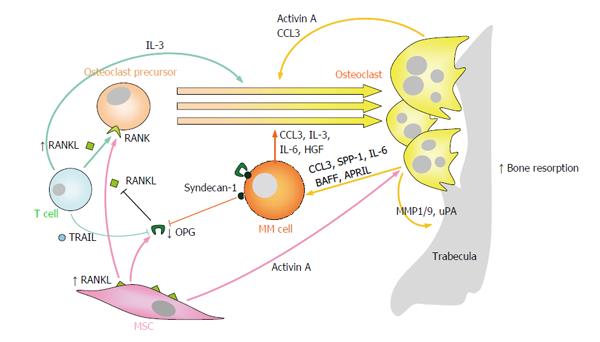Copyright
©2014 Baishideng Publishing Group Inc.
World J Stem Cells. Jul 26, 2014; 6(3): 322-343
Published online Jul 26, 2014. doi: 10.4252/wjsc.v6.i3.322
Published online Jul 26, 2014. doi: 10.4252/wjsc.v6.i3.322
Figure 1 Enhanced osteoclast formation and resorption partially mediates the development of myeloma bone disease.
Numerous “OC-activating factors” produced by multiple myeloma cells and other cells in the bone marrow microenvironment (including RANKL, CCL3, activin A, IL-3, HGF and IL-6) readily promote OC differentiation from OC precursors and/or stimulation of OC resorptive activity. In MM, the RANKL/OPG ratio is clearly favored towards RANKL, both because of increased expression of RANKL on MSCs and T lymphocytes, and because of reduced expression of OPG by MSCs and inactivation of OPG through binding to TRAIL or syndecan-1 on the surfaces of myeloma cells. On the other hand, OCs produce several factors (e.g., IL-6, CCL3, BAFF and APRIL) which promote the growth and survival of multiple myeloma cells. RANKL: Receptor activator of NFκB ligand; NFκB: Nuclear factor-κB; CCL3/MIP1α: Macrophage inflammatory protein 1-α; IL-3/6: Interleukin 3/6; HGF: Hepatocyte growth factor; OPG: Osteoprotegerin; RANK: Receptor activator of NFκB; TRAIL: Tumor necrosis factor-related apoptosis inducing ligand; BAFF: B-cell-activating factor; APRIL: A proliferation-inducing ligand; SPP-1: Osteopontin; MMP1/9: Matrix metalloprotease 1/9; uPA: Urokinase plasminogen activator; MSCs: Mesenchymal stromal cells; OC: Osteoclast; MM: Multiple myeloma.
- Citation: Garcia-Gomez A, Sanchez-Guijo F, del Cañizo MC, San Miguel JF, Garayoa M. Multiple myeloma mesenchymal stromal cells: Contribution to myeloma bone disease and therapeutics. World J Stem Cells 2014; 6(3): 322-343
- URL: https://www.wjgnet.com/1948-0210/full/v6/i3/322.htm
- DOI: https://dx.doi.org/10.4252/wjsc.v6.i3.322









